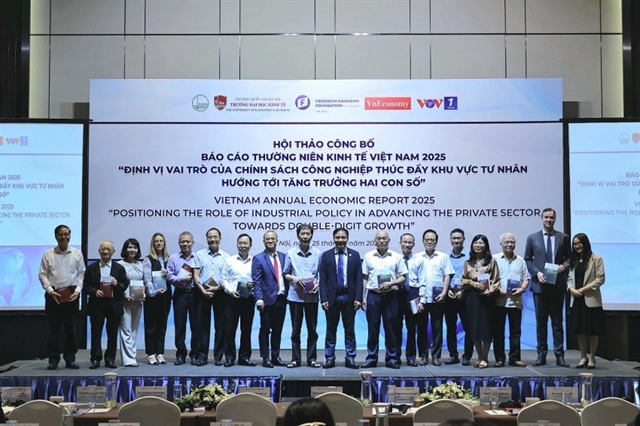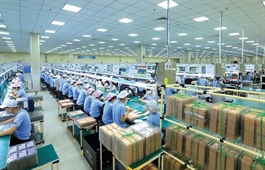Report highlights role of industrial policy towards double-digit growth
Report highlights role of industrial policy towards double-digit growth
The Vietnam Annual Economic Report 2025 by the University of Economics and Business (UEB) and the Friedrich Naumann Foundation (FNF) was released on June 25 in Hanoi.

Nguyen Truc Le, UEB's chairman |
Vietnam is targeting double-digit economic growth to escape the middle-income trap and realise the national development goals.
In this context, positioning the role of industrial policy to promote the private economic sector, which contributes more than half of GDP and is the main pillar of employment, is a key factor.
Nguyen Truc Le, UEB's chairman, said that although Vietnam's economy has recovered strongly after the pandemic with GDP growth at 7.09 per cent in 2024 and nearly 7 per cent in the first quarter of 2025, there remain structural bottlenecks, especially related to industrial policies and the private sector.
In particular, labour productivity in the private sector remains low. The private sector currently contributes about 50 per cent of GDP, 30 per cent of budget revenue, and 82 per cent of total labour. However, labour productivity, technology, and level of chain links are still low.
"The current growth model still depends heavily on foreign investment and raw exports. Total factor productivity (TFP) is low and has even been negative for many years," he said.
He also pointed out issues like industrial investment without industry-regional focus. Support policies have not created a push for domestic enterprises to enter the global value chain. Research and development (R&D), digital infrastructure, and connections between the public and private sectors are too weak. Policies need to be more synchronised and have a regular and effective monitoring mechanism.
He shared about the experience of East Asian markets, such as Japan, South Korea, Taiwan, and China, saying, "No economy can escape the middle-income trap without a proactive, selective and long-term industrial policy."
Japan and South Korea have invested systematically in foundational industries, along with export strategies and better quality workforces. Taiwan has achieved success thanks to an innovation-oriented industrial policy, focusing on semiconductors and high technology. China combines institutional reform with the construction of key industrial clusters, then enhancing endogenous capacity.
"These countries have one thing in common. Industrial policy, once considered a market-distorting intervention, is now being re-used by many developed and developing countries as a proactive tool to build production and technological capacity and ensure sustainable development and economic security. The efforts of the US, the EU, South Korea, Japan, China, and many other countries in recent times are clear evidence of this trend," Le emphasised.

Vanessa Kristina Steinmetz, FNF Vietnam's country director |
Vanessa Kristina Steinmetz, FNF Vietnam's country director, said that as global markets experience unprecedented volatility and uncertainty, Vietnam stands at a crossroads, as it is not just aiming to keep the economy growing but aiming for bold, double-digit growth. That goal shows a strong drive to break out of the middle-income trap and build a better, more prosperous future for everyone.
At the heart of this transformation lies a fundamental liberal principle: the private sector serves as the most dynamic and innovative engine of sustainable economic growth.
"However, realising double-digit growth requires more than recognising the private sector's importance, it demands creating the institutional framework that allows market forces to flourish while addressing market failures intelligently and efficiently," she emphasised. "That means creating smart frameworks, simplifying regulations, ensuring fairness, and supporting access to capital, technology, and skills."
Also at the conference, domestic and foreign economists joined a panel discussion on Vietnam's economic growth in 2025 and prospects for 2026-2030. They also discussed challenges and proposed solutions for Vietnam to achieve its growth target of 8 per cent or more in 2025, and double-digit growth from 2026-2030.
|
The Vietnam Annual Economic Report is an annual publication the UEB has produced over the past 17 years, including independent and objective analysis of achievements, difficulties, opportunities, and challenges in the development process, contributing a scientific basis to macroeconomic policymaking, as well as discussing economic issues in Vietnam.
- 15:29 26/06/2025



























